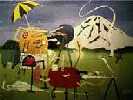|
|
|

|
|
Scale
Projects may be individual or done in
small groups (2 to 4 students).
Topic
Any topic is acceptable so long as it is related to the course
topics. Specifically, while programming-oriented projects are
recommended, literature reviews or other 'report oriented' projects
may be acceptable as well. Furthermore, if you are already working on a
relevant project (e.g. quals or thesis) check with Dan, since work on
it may well count for the project component.
It is highly recommended that you meet with or email Dan a description of hwat you are interested in doing soon to get the discussion going. Even a short paragraph suffices to start the conversation rolling.
Ideas
Click here for some ideas of possible projects.
Proposals
Click here for the proposals you submitted..
The ideal proposal would
- Be written in HTML and delivered as a URL which I could link to on the
class site. You can then update it as time progresses.
- State clearly the problem you are addressing and what you hope to
create as an artifact. Technically, you could satisfy this requirement with
a single sentence (and some groups did with the preproposal), but this time
I'm looking for much greater detail. If your project has a big UI
component, can you include a figure showing what it might look like? Can
you include an architectural diagram? The more detail the better, and of
course you can change your minds later.
- Break the project's development into (much) smaller chunks. Describe
each chunk thoroughly. What dependencies are there between the pieces? Can
you connect the overall project as a linked schedule or pert chart?
Estimate the estimate the time required to develop each chunk and sum up
the total time along critical paths. If your group has multiple people, who
will work on each chunk?
Most likely, these plans will change as time evolves, but it is a very
useful exercise to plan it out anyway.
- Describe the series of milestones you expect to pass as a way of us
each being able to monitor progress. I've previously said "2 week
intervals", but unless there's substantially some better schedule, let's
standardize on the following dates:
- Jan 30 - proposal due
- Feb 13 - milestone 1 due
- Feb 27 - milestone 2 due
- Mar 12 and 14 - project presentations, demos, etc.
- Mar 21, no exam - instead reports are due via email by midnight.
- List and third-party software you think you might use.
- If machine learning is involved in your project, describe where you'll
get your training (and testing) data
- Explain how you will evaluate
success. What will you measure, how will you measure it, how will you
display it in the final report? (graphs are usually better than tables if
you can think of a good way to visualize the data)
Guidelines for Final Presentations
- Length: TBD
Be sure to practice presentation & gauge length
- Powerpoint or PDF Slides (Max 10)
Mail to me by 11am on day of presentation unless you will bring your
own laptop.
- Every team member should talk for some of the slot
- Subtopics to cover:
- Aspirations & reality of what you built
- Demo?
- Suprises (What was harder or easier than expected)
- What did you learn?
- Experiments & validation
- Who did what
Guidelines for Final Reports
Be sure that your writeup contains:
- Team and member names (one report per group).
- Your goals for the project
- Your system design and algorithmic choices
- Sample screens of typical usage scenarios
- Experiments and results that show how effective your system
is, and
where it could be improved. For example, you might show a precision /
recall curve for different types of extraction algorithms. Graphs (if
informative) are better than large tables of numbers. See some of the
papers in the reading. The
Kylin paper is not particularly unusual in this respect, but may
give you ideas.
- Anything you considered suprising or that you learned. WHat would
you do differently if you could?
- Conclusions and ideas for future work
- Appendicies:
- Which people did what parts of the work? Were there problematic
dynamics in your group?
- What externally-written code (if any) was used in your project?
- Instructions on how to start and use your project (including OS
or browser requirements, pointer to a README file (or include that
inline). Is there a website to visit?
There is no limit on length, but we appreciate good organization and tight,
precise writing. Points off for rambling and repetition.
What to Hand In:
- By midnight on March 21, please hand in a hard-copy of your
report as well as an electronic version of both the report and the
code. We will supply details on the electronic hand-in process via the
class mailing list.
- Late submissions for the final project and writeup will not be
accepted, as it will be the end of the quarter. Sorry! (But happy
holidays).
|


 CSE Home
CSE Home  About Us
About Us Search
Search Contact Info
Contact Info